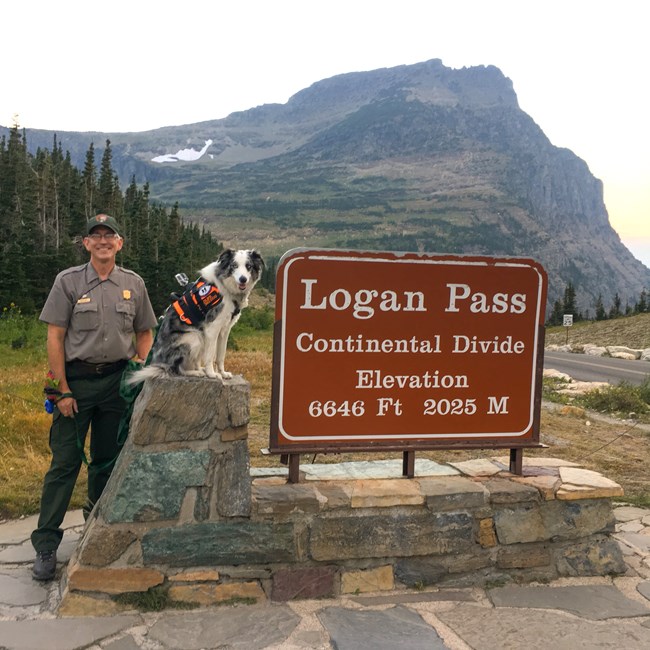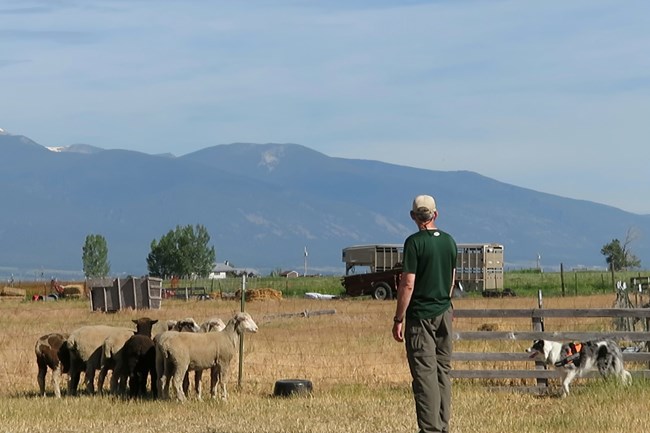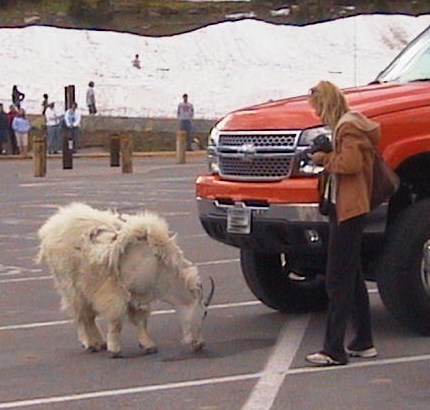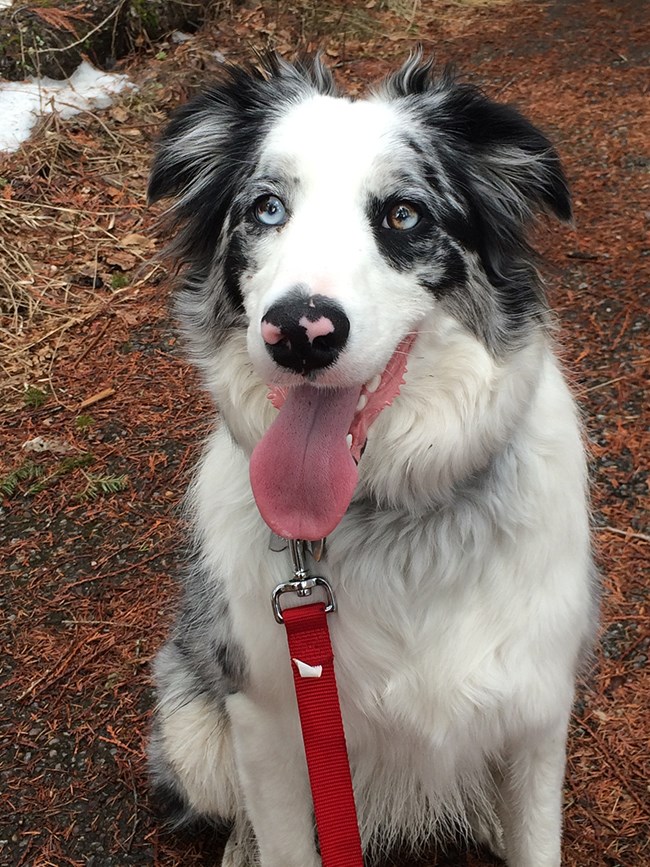Last updated: April 18, 2019
Article
Wildlife Shepherding in Glacier National Park

NPS/A.W. Biel
Background
In July 2016, Glacier National Park became the first National Park Service unit to use an employee-owned dog to help manage habituated wildlife. In recent years, increasing park visitation has led to an increase in human–wildlife interactions at Glacier and other national parks. The goal of Glacier’s wildlife shepherding program is to keep park visitors and wildlife a safe distance apart.
Glacier's Natural Resources Program Manager, Mark Biel, uses his professionally trained border collie, Gracie, to move bighorn sheep and mountain goats out of areas of high visitor use, such as the Logan Pass parking lot. In the winter, they move deer out of the park’s headquarters/residential area, which helps reduce the presence of mountain lions in this populated space. Gracie works only with ungulates—not with bears or other predators.
“Ranger Mark” and Gracie are also wildlife-safety ambassadors, helping remind people to stay a safe distance from all wildlife. A big part of their job is talking with park visitors about why approaching, touching, and feeding wildlife is dangerous for both people and animals. The "bark ranger" team also visits with schools and other groups about these issues and maintains an Instagram account. The project is funded by the park’s friends group, the Glacier National Park Conservancy.

NPS/A.W. Biel
Training
Through a grant from the Glacier National Park Conservancy, Gracie was trained at the Wind River Bear Institute, in Florence, Montana. The training took 10 weeks. Gracie learned many verbal commands to control her direction and speed of movement. Perhaps most important is the recall command, which ensures she can be called off of anything at any time and immediately return to her handler. Then Gracie was taught to move domestic sheep in response to the commands. Gracie and her trainers also spent lots of time learning how to properly meet and greet people. Gracie's owner, Glacier employee Mark Biel, was trained to be her handler. The Wind River Bear Institute is known primarily for training Karelian bear dogs.
How It Works
Wildlife shepherding works by applying pressure from a distance. Gracie is trained not to make physical contact with wildlife. Once wildlife have moved a safe distance away, the shepherding stops. At Logan Pass, the animals typically move 30–75 yards away from the parking lot, where they can still be seen and photographed by visitors. Sometimes, just seeing Gracie is enough to help wildlife decide not to enter the parking lot. When on duty, Gracie wears an orange vest indicating that she is a wildlife working dog. She only works on-leash at Logan Pass.

NPS/A.W. Biel
Wildlife shepherding is another tool in the toolbox to help keep habituated wildlife from becoming desensitized to one hazing method or another. Park employees also use conventional hazing methods (arm-waving, shouting, use of sirens, shaking cans of rocks, and moving vehicles) to move goats and sheep out of the Logan Pass parking lot. With these methods, however, the animals often return in a short period of time. When Gracie is used to move wildlife, they have remained out of the area for 15 minutes to 9 hours, versus 10–15 minutes with the traditional techniques. This is likely because mountain goats and bighorn sheep have an innate fear of predators.
Wildlife shepherding is done at Logan Pass once or twice a week during the summer months. Shepherding is not done if it is too hot, if there are other wildlife (such as grizzly bears) in the area, if the animals seem excessively stressed, or if there is too much traffic and crowding in the parking lot.
What It Looks Like

NPS
What is Wildlife Habituation?
Scientifically speaking, habituation occurs when animals are repeatedly exposed to the same stimulus, and eventually stop responding to that stimulus. Wild animals should have a fear of humans, but in Glacier National Park, many wild animals are constantly exposed to people. As a result, they lose their fear of humans. When wild animals no longer see humans as a threat, they may allow humans to come very close to them—or approach humans themselves.
Habituation is dangerous for both animals and humans. When closely approached or provided with human food, bighorn sheep and mountain goats can become aggressive; each has the ability to kick, bite, gore, or trample when feeling threatened. This can cause injury—or in rare cases, death—to people and can cause the animal to be lethally removed from the population.
Please remember that these are wild creatures. If they seem tame, it is because they have become habituated to humans, and that is not natural. Help park animals live natural lives—remember to stay 25 yards away from all wildlife except for bears and wolves, which require a distance of 100 yards. Wildlife may not know better—but YOU do!


NPS/A.W. Biel
Pets in Glacier National Park
Dogs are allowed in many national parks—but what they can do, and where they can do it, varies by park. Gracie is allowed to perform wildlife shepherding because she's been extensively trained to do that job for Glacier National Park, supervised by a park employee who's been trained as a wildlife biologist and as Gracie’s handler. There is also a plan and permit in place that outlines what Gracie will do and where she will do it.
Pets visiting Glacier National Park must always be leashed. They are allowed only in developed areas, in frontcountry campgrounds and picnic areas, along roads, in parking areas, and in boats on lakes where motorized watercraft are permitted. You can learn more about pets in Glacier by visiting the park’s website.
